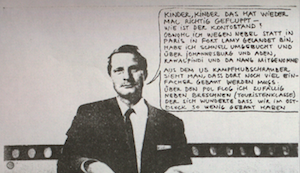Image: Dr. Georg Lippsmeier (by Nedjat Sulejman-Pasic, 1975) with a humorous speech bubble giving a fictive, but typical, impression of one of his many travel accounts. © courtesy of Kiran Mukerji
Many architectural histories focus on particular buildings, well-known oeuvres or individually commissioned designs, without engaging how built environments are simultaneously products of transactional thinking and financialized property. Architects are regularly portrayed as independent masterminds, more akin to artists in ateliers rather than entrepreneurs involved in profit-making ventures at a variety of scales. with this special collection, we aim to correct this myopic view by investigating architects as commercially-oriented practitioners whose activities are strongly tied to property developers, private investors and construction companies.
The contributions to this special collection embed entrepreneurial architects more firmly into the narrative of modern architectural history. By doing so, we hope to broaden the perspective on the agencies and mechanisms through which the diffusion of architectural typologies and property mechanisms occur. Throughout the modern period architects and the firms for which they worked travelled the world to propose revolutionary ideas and learn about new developments elsewhere, leading us to posit that the transnational circulation of architectural and planning knowledge seems more frequently driven by economic expansion than philanthropic mindsets or intellectual hunger.
Guest Editors
Monika Motylinska, Leibniz Institute for Research on Society and Space, Erkner Tim Verlaan, University of Amsterdam
Editorial
Introduction: Architects as Global Entrepreneurs in the Long 20th Century
Monika Motylinska and Tim Verlaan
Research Article
Building ‘Holland’s Tallest Office Block’: The Transnational Origins and Troubled History of a Speculative Office Development in Post-War Rotterdam
Tim Verlaan and Alistair Kefford
2021-11-12 Volume 9 • Issue 1 • 2021 • Volume 9 • 15
Also a part of:
From IB74 to US Patent 4438616: The (re)making of a profession
Janina Gosseye and Donald Watson
2022-02-18 Architects as Global Entrepreneurs (1850-2000)
Also a part of:
The Business of Beaux-Arts: Architecture, Racial Capitalism, and Branqueamento in Belle Époque Brazil
David Bijan Sadighian
2023-11-01 Architects as Global Entrepreneurs (1850-2000)
Also a part of:
Collections
-
The Two Mediterraneans that Live Apart, Together: Making Architectures and Writing Histories
Women’s display. Women’s exhibitions and exhibition design in the 20th century
Building Civic Identities. Communal Palaces in Italian Urban History (14th-17th Centuries)
Intersecting Practices: Architecture and the Visual Arts in Early Modern Europe - Italy and the Netherlands
The Geopolitical Aesthetic of Postmodernism
Architects as Global Entrepreneurs (1850-2000)
From Ration Cards to Refugee Camps: Architecture, Bureaucracy, and the Global State of Emergency during World War One
Comprador Networks and Comparative Modernities
Architectural Historiography and Fourth Wave Feminism
Marxism and Architectural Theory across the East-West Divide
Resilience in Architectural History
On Style
On the meaning of 'Europe' for Architectural History
Travel
Building Word Image: Printing Architecture 1800-1950
Objects of Belief: Proportional Systems in the History of Architecture
Culture of Crisis
